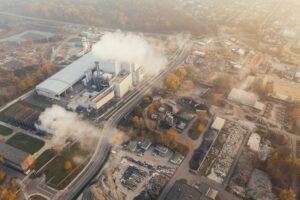Circularity in the Chemicals Industry: Drivers, Challenges and Solutions
Here’s an eye-watering reality check on why we need to up our game and reconsider our consumer habits. The global economy recycles only about 10% of the resources it consumes. Yes, 10%. On top of that, about half of all global greenhouse gas (GHG) emissions come from the production of new everyday goods, assets and land use practices, according to The Platform for Accelerating the Circular Economy (PACE) and Ellen MacArthur Foundation . The International Energy Agency (IEA) recently reported the chemical industry is the third-largest industrial CO2 emitter after steel and cement and is responsible for about 4% of total global direct emissions.
What’s Driving Interest in the Circular Economy in the Chemicals Industry?
There is some good news here, though. A combination of key drivers, including corporate demand for differentiation, consumer calls for environmentally sustainable practices, plus regulatory pressure for waste and emissions reduction means that circularity of the chemicals industry is beginning to take shape.
On a macro scale, international, regional and local sustainability initiatives such as zero landfill/3R, Extended Producer Responsibility (EPR) and carbon pricing are incentivizing countries and companies to change their status quo. In 2018, the EU launched its first regional policy framework, the ‘EU Strategy for Plastics in a Circular Economy’. The framework used a material-specific lifecycle approach to integrate circular design, use, reuse and recycling into plastics value chains. In the last decade, at least 10 countries in Europe and Asia-Pacific, including China, Singapore, Malaysia, Taiwan and New Zealand, developed preparatory initiatives, including metrics, roadmaps and national strategies, to transition to—and eventually implement—circular economy principles. Innovators are also leveraging other energy and environmental policies, such as the US Low Carbon Fuel Standard, to indirectly support similar objectives.
The business case for adopting circularity in the chemicals industry is also becoming more compelling due to the shifting demand from both consumers as well as key downstream markets, including utilities, transportation, textile and apparel, electronics, cleaning products, food and agriculture, and cosmetics and beauty. Many seek performance enhancements while using sustainable materials and chemicals and are also designing for closed-loop recycling to reduce waste and carbon footprint. In addition to striving to meet the UN’s Sustainable Development Goals (SDGs), some chemical majors are partnering with downstream clients, universities and startups to co-design and implement products and circular economy business models. The aim of these collaborations? Decoupling growth from resource use and emissions, reducing resource inefficiencies across their product lifecycles and enhancing profit margins.

From the perspective of many chemical companies, the cost of implementing circularity principles across the value chain outweighs the benefits in the short term. Abiding to circular economy-related laws, regulations and demands—many of which require reforming production processes and supply chains—can place a large financial burden on the chemical companies which typically operate at very narrow profit margins. Additionally, the deployment of deep circularity interventions relies on access to cost-effective sustainable energy and renewable/recyclable feedstock with appropriate specifications. It also hinges on the availability of suitable recycling and emissions capturing infrastructure. Complicating matters even more, the growth of increasingly complex combinations of materials and substances, and the additional mixing and contamination that occur as the products are transacted in the market, makes it difficult to track, collect, separate and reuse them. Even after its acquisition, properly matching the available volumes of sustainable/recycled feedstock with the relevant applications at scale adds another layer of complication. While several chemical majors explicitly include circularity initiatives in their sustainability strategies and operations, and have joined global initiatives to advance closed-loop recycling of plastics such as the Alliance to End Plastic Waste, a lot more needs to be done on the policy and legislation levels to stimulate the scaling of circular economy principles across materials and chemical value chains.
Some Chemical Companies are Stepping Up
Regardless of the seemingly overwhelming challenges, circular economy interventions are increasingly being deployed by major chemical companies. With the goal of galvanizing the circular economy, about a dozen chemical company majors launched sustainable feedstock and resource recovery solutions in 2019 alone via their corporate Venture Capital arms as well as their R&D and/or internal business innovation units. While circularity-related business models adopted by chemical companies depend on where they operate in the value chain and the downstream markets they serve, there are some common investment and innovation themes.
Internal circularity interventions are mostly directed at incorporating sustainable/waste feedstock or enhancing the recyclability or biodegradability of final products in the early stages of product design. Royal DSM and Eastman, two of the major specialty chemicals and materials companies, deployed new targets or products to use sustainable feedstock with Dyneema® fibers (aiming to incorporate 60% bio-based feedstock by 2030) and Naia™ cellulosic yarn (sustainable fabric collection), respectively. Several companies also launched internal waste-to-chemicals and waste-to-fuels initiatives. For example, Evonik’s Rheticus II, deploys artificial photosynthesis by using CO2 to produce chemicals, and DOW’s joint development with RB, and Drukpol. Flexo, together with its partnership with Mespack Partners, provides packaging solutions designed to be recycled. Chemical companies are increasing their focus on chemically recycling mixed polymers to reuse the molecular building blocks without jeopardizing quality. The launch of Eastman’s Carbon Renewable Technology in 2019 attests to that.
Partnerships Help Forge the Way to Circularity
Chemical companies have also launched several external partnerships and investments to align with their internal initiatives. In the sustainable feedstock space, for example:
• DOW partnered with UPM Biofuels to commercialize its plastics offering for packaging made from wood-based renewable feedstock
• Royal DSM partnered with French biochemical specialist, Metex, to scale the deployment of bio-based, non-GMO feedstock for natural cosmetics
• Covestro partnered with Genomatica (also a technology licenser for BASF in 2013) to develop high-performance materials based on renewable feedstocks.
In terms of resource recovery, a handful of chemical majors have deployed large scale waste-to-fuels/chemicals projects. As part of its ChemCyclingTM project, BASF invested in Quantafuel, a specialist for pyrolysis of mixed plastic waste and purification of pyrolysis oil, DOW partnered with Fuenix Ecogy Group to supply pyrolysis oil feedstock made from recycled plastic waste. Nouryon joined Enerkem, Air Liquide, Port of Rotterdam and Shell to develop a waste-to-chemicals plant to produce advanced bio-methanol from waste. Additionally, Nouryon partered with Gasunie to supply green hydrogen to BioMCN, one of Europe’s largest methanol producers, for the production of renewable methanol from CO2.
Keep an Eye on other Resource Recovery Solutions for Changing Downstream Markets
The onset of vehicle electrification and fuel efficiency policies and standards is driving significant demand from the specialty materials and chemicals industry, particularly for lightweight composites and battery recycling for precious metal recovery. For example, the EU plans to unlock up to $9 billion in investments toward the lithium-ion battery value chain, from mining to manufacturing to end-of-life management, via the European Battery Alliance.
The project includes Solvay, BASF SE, among other downstream incumbents such as BMW AG and Fortum Oyj. BASF also co-founded the “Recycling Li-ion batteries for electric Vehicle” (ReLieVe) project, with Eramet and SUEZ, which received €4.7 million by EIT Raw Materials to develop an innovative closed-loop process for the recycling of lithium-ion batteries. Moreover, Solvay is investing heavily in developing solid-state polymer electrolytes and Solvay Ventures is focusing on battery start-ups with investments in Nohms, Solid Power and Imprint Energy partially to support vehicle electrification and light-weighting, which also support circular economy initiativ


